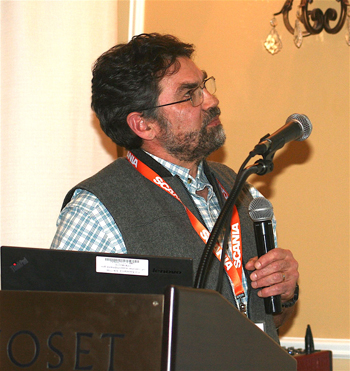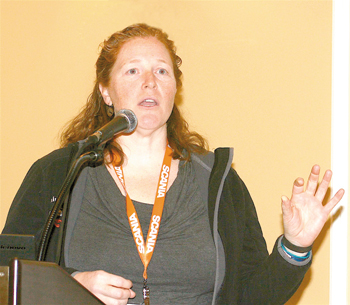Earlier Female Lobster Maturity Could Affect Eggs
by Laurie Schreiber

Rick Wahle, University of Maine. “The good news is that, from New Brunswick to New Hampshire in 2019, we saw a pretty significant upturn.” Laurie Schreiber photo.
A new study shows that female lobsters appear to be reaching maturity at a younger and smaller age.
The phenomenon could have implications for the number of eggs the smaller females are able to bear, Jess Waller, a lobster research biologist for the Department of Marine Resources (DMR) said during a session on lobster science during the Maine Fishermen’s Forum in early March.
Waller said the last research on the topic was conducted in the 1990s.
“We know conditions in the Gulf of Maine have changed significantly since then,” she said. “And we’ve heard on the water that fishermen are seeing small and smaller females.”
The data can be used to estimate the number of egg-bearing females in the population, which will in turn inform the lobster stock assessment, she said.
The study began in 2018, when female lobsters were collected from around Boothbay Harbor. Collections were performed in additional areas in 2019. The lobsters were brought to the DMR’s lab in Boothbay Harbor. Fourteen measurements were performed on each, including external measurements such as lengths, weight, and condition of the shell. To determine whether the female was mature or immature, researchers also looked at key features such as eggs developing inside the female.
Depending on area, researchers found that mature females ranged in size from 3.5 to 3.7 inches in carapace length in the 1990s, compared with 3.3 to 3.5 inches today.
“We see differences in size at maturity between areas and, in general, a decreasing size at maturity” as smaller females become capable of egg production, she said.
The study linked water temperature to the change in size.
“As water temperatures rise, size at maturity decreases,” she said.
Smaller size means the growth rate of females might be slowing down earlier, which could have an impact on egg production.
Smaller size might also increase the length of time the female will produce eggs through her lifetime, but the eggs might not be as high quality as eggs produced by larger females, she added.
The DMR gave its data to stock assessment scientists for consideration in 2020. The study will continue this year with collections in additional areas and partnerships with other New England states interested in study size at maturity in the Gulf of Maine and Georges Bank.
Larval survey

Kathleen Reardon, University of Maine. “We can’t answer these questions without fishermen reporting recaptures of tagged lobsters.” Laurie Schreiber photo.
The DMR also conducted larval surveys in Zone E.
“We’re looking for the four larval stages of the lobster’ life,” Waller said.
Lobsters hatch from eggs in the summer and undergo four stages of larval molt before settling on the sea floor.
During the four stages, larvae live on the surface, so they’re subject to changes in current, winds, light intensity, predation, and more.
“That make them hard to find in the environment and hard to predict where they’ll be,” she added.
It takes about a month to grow from stage 1 to 4.
Researchers used a Neuston net to gather larvae. The Neuston is a type of net used to sample everything in the first 6 inches of the water column.
Back at the lab, everything from the net was identified and counted.
“We try to survey in this area from the time we start to see egg hatching to the time we think settlement occurs,” she said. “We’re trying to figure out the abundance of these larval stages and track changes in the larval season.”
A few more years of data are still needed before trends can be determined, she said; 2020 will be the third year of data collection.
The survey areas were selected based on surveys conducted by the University of Maine and Bigelow Laboratory in the 1990s.
“That will let us evaluate changes over time,” she said. “We’re building up a unique data set. A long-term goal is to be able to connect our larval survey to the results of the settlement survey in this area.”
Settlement index
Lobsters are moving
regularly and,
in some cases,
long distances.
The lobster settlement index is led by Rick Wahle, a research professor with the University of Maine’s School of Marine Sciences and director of the Lobster Institute.
The settlement survey, which has been underway for more than 30 years in some of places, covers the region from Rhode Island to Newfoundland and includes collaborations with numerous academic institutions, government agencies, industry groups, and businesses.
The survey uncovered a surge of larval settlement from 2005 to 2008 that may have played an important role in the subsequent surge in landings from 2010 onward, he said.
However, there was a settlement slump for five or six years throughout the Gulf of Maine.
“But the good news is that, from New Brunswick to New Hampshire in 2019, we saw a pretty significant upturn,” he said. “Let’s hope that bodes well.”
Tagging
Lobsters travel considerable distances, which could have implications for migration and habitat use patterns over time, said Kathleen Reardon, the DMR’s lead lobster biologist.
The DMR has been conducting a lobster-tagging project in collaboration with the Atlantic Offshore Lobstermen’s Association and New Hampshire Fish and Game Department. The project involves lobstermen taking samplers out on their boats to catch, tag, and release lobsters.
“We can’t answer these questions without fishermen reporting recaptures of tagged lobsters,” she said.
Tagging started in 2015 on Georges Bank and expanded inshore in 2017.
General trends show that lobsters are on Georges Bank in the warmer months. In the cooler months they’re in the deep canyons. Some lobsters migrate over 50 miles, she said.
“We’ll be collecting and analyzing that data for the next year or two,” she said. “What have we learned? Lobsters are moving regularly and, in some cases, long distances. There are differences between inshore, nearshore and offshore habitats and between the Gulf of Maine and Georges Bank. We’ll be digging into this data.”
